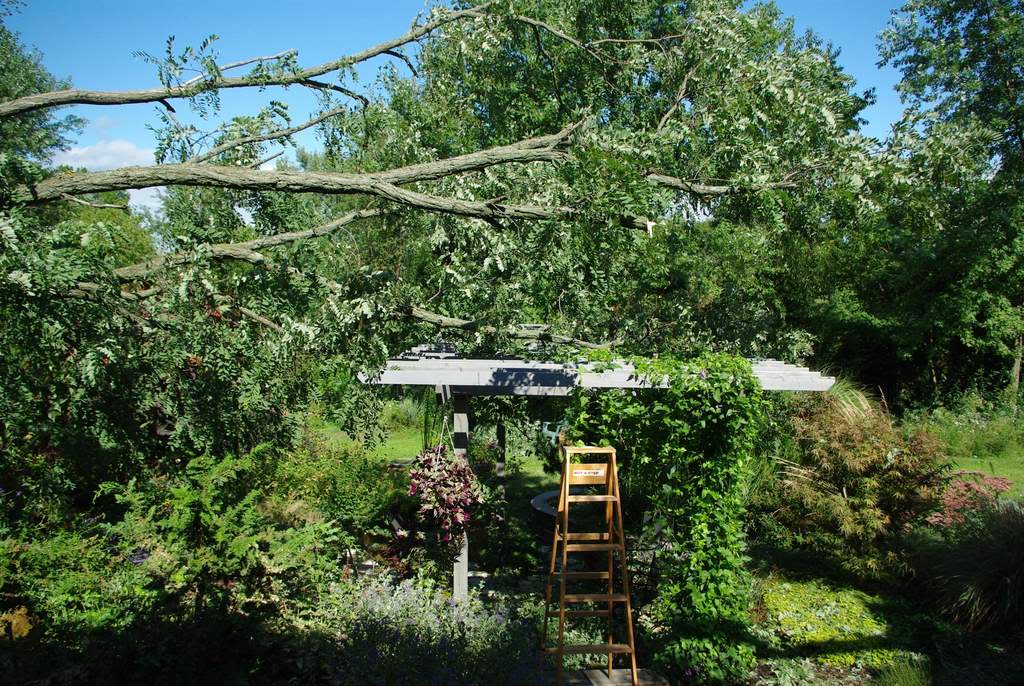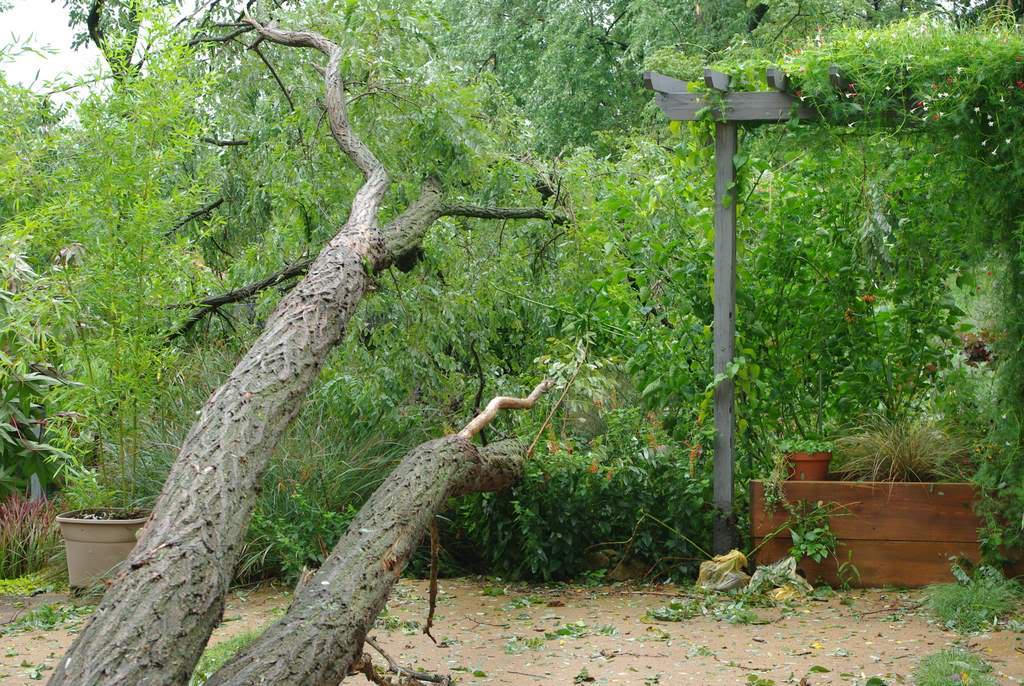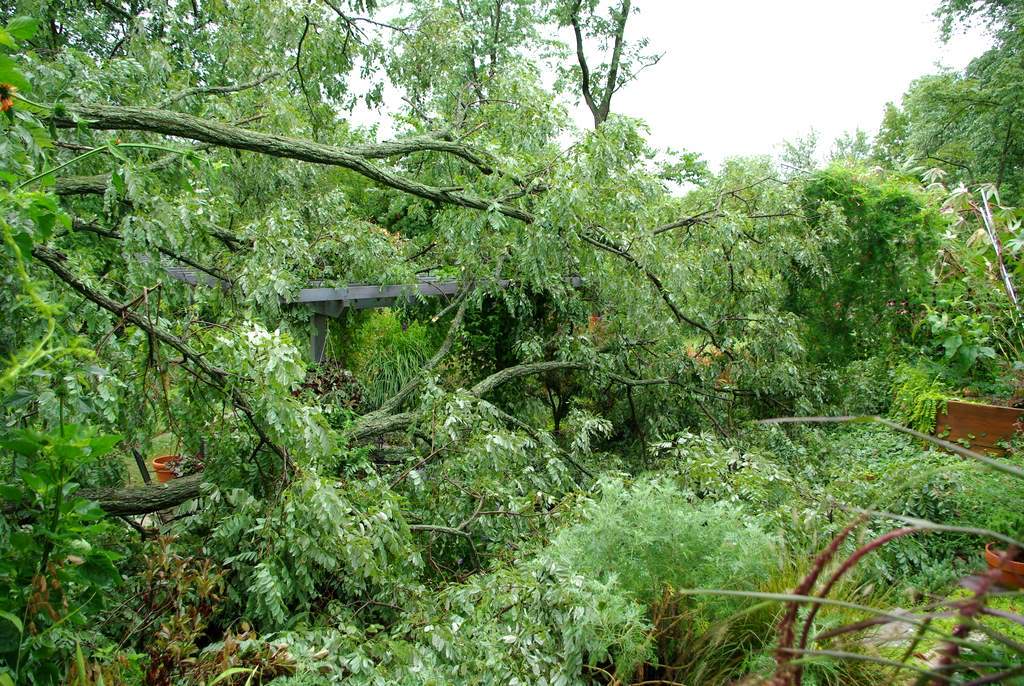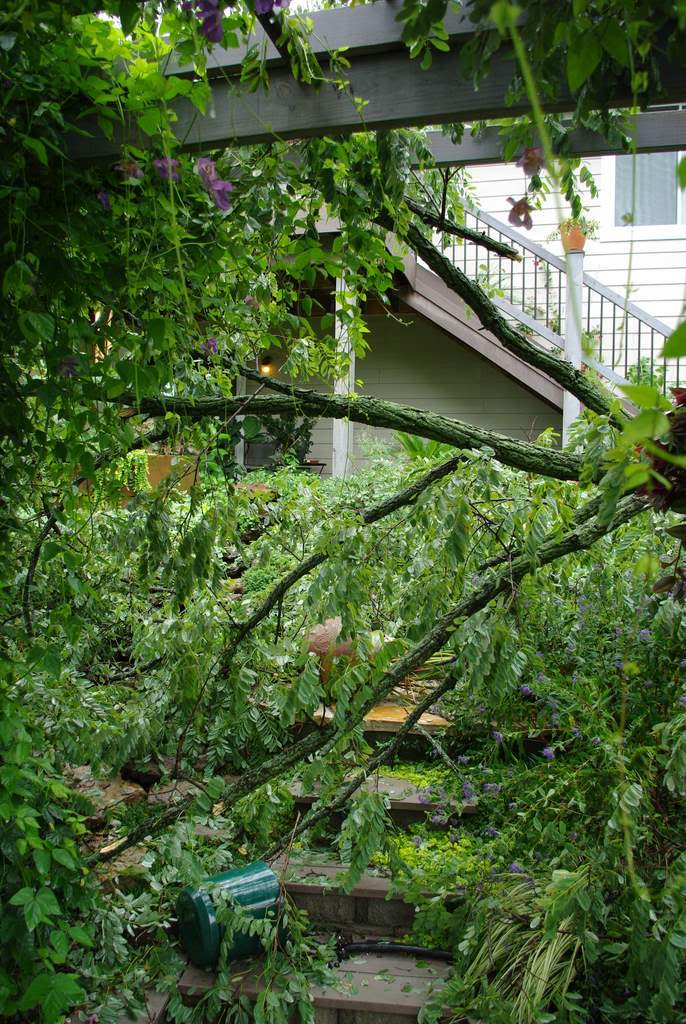I'll start today by taking a look at what exactly happened.
From the photo above you may have guessed that a tree fell down. Before we take a closer look at what damage it caused, he's a video clip I took less than 5 minutes before the tree blew over:
As you can see, it was quite a strong storm, dumping 4" or more of rain in just 30 minutes or so, and sporting very powerful gusty winds. It's just by chance that I didn't get video of the tree blowing down, as I was recording for a few minutes, stopping for a few minutes, recording for a few minutes, etc.
Here's the downed tree seconds after it fell, while the rain was still falling:
Oh no. I was hoping to add a large tree to my garden, but not like this! I'm not looking forward to rebuilding the pergola, and since I'd already replaced one new tree this year, I certainly didn't want to have to replace another one -- especially a healthy one!
Since the storm was big and powerful but moving quite fast, the rain stopped not too long after the tree came down, so I was able to go outside and survey the damage:
It looked bad. Remarkably though, the tree missed the small pergola over the triangle box, missed the large potted bamboo, and doesn't appear to have crushed the main pergola.
Upon closer inspection, the base of the tree (which ended up being my neighbor's) was lower than my driveway, so when it fell over it hit the edge of the concrete and was propped up -- the trunk never hit the ground! Looking at the first image of this post again, you can see this:
Since our cars were trapped in the garage, I had to get the tree cleared right away, so I got started with my trusty bow saw on the limbs over the pergola:
 |
| Storm? What storm? Look at that sky! |
Next it was chainsaw time:
I wish every fallen tree I had to cut up over the years had come down like this -- it made removal of the tree so easy (and quite a bit of fun, all things considered)!
Although there was a lot of debris to pick up, and some smaller plants got crushed, the only damage to a "permanent" plant was the top 6 inches of my Fernspray False Cypress (Chamaecyparis obtusa 'Filicoides') cracked off. (It's the dark green evergreen at the left side of the last image above.) For many trees this would be a problem, but there are several branches on this one that can take the place of the main "leader" (trunk), so I'm not concerned.
It's amazing that a huge tree fell on top of this patio, and did essentially no damage. Incredible.
A week or so after the big storm, I planted that potted bamboo that narrowly missed being crushed by the tree.
I decided to plant it here in one of the original raised beds, as the plants here are nothing special, and can be moved if worth saving.
As much as I like my neighbors, we can use a little more privacy here as our decks are pretty much right in line, and the bamboo should be perfect for that.
After digging out the plants I removed the soil from the box so I could add corner supports and line the bottom with hardware cloth to keep the moles (and voles) out of here:
Important time-saving tip: put soil on a tarp instead of bare grass. It will save your lawn and cleanup time too. Since a good part of the tarp is actually on my neighbor's lawn, it's extra important that I don't leave a mess.
Here's the plant which I dug from a large local grove of Yellow Groove bamboo earlier in the spring (but didn't mention before). It's the same species I had already purchased this year, but after talking to my neighbor about buying it he mentioned that there is a large bamboo grove at his church, and I could probably dig some for free. So I did (after getting permission) and potted the plant up in this tub.
That's about four months of rhizome growth. I love the way they all deflected downward at the same angle.
I didn't take any photos of the finished project, but I've got plenty of later photos of this plant. It's the same one as in the floppy bamboo post, as well as the post about the monster rhizome escape.
Soon after this, I took my third trip of the year to Needmore Bamboo, as I wanted to get another species of bamboo for a specific planting bed. Although it's a 250-mile trip (one way), it's worth it to me because I can get much larger plants than I can locally. Plus Brad grows many more species than I can get locally, so there's much greater selection.
As before I went for a single plant (the yellow-culmed plant on the left) and came back with much more. In this instance Brad had several plants he wanted to get rid of -- he didn't have room in his greenhouse so didn't have a reliable way to protect these over the winter. I think he knew that these free plants would guarantee that I'd be coming back for more in the future (and he was right).
The spot I wanted to plant this new bamboo (the single plant, not all of the extras I got) was next to the patio where I had created a terraced planting area a few years ago. Here's the old photo from 2004:
This area now looks too busy, and needs a more dramatic plant, so I removed the three small terraces and instead created one large planting bed:
The scale of this fits with the rest of the patio much better, and the bamboo will definitely be dramatic once it gets a bit bigger.
One small forgotten project that I squeezed in somewhere earlier in 2008 was building a more elaborate trellis for my climbing rose:
It's copper pipe and fittings, my material of choice for "permanent" trellises (whereas electrical conduit and hose clamps are my choice for temporary trellises).
So that's a look at 2008 in my garden. It was certainly a busy year.
Only one more year of history before we're all caught up with the start of this blog. I do hope something interesting happened in 2009...
























Wow, you crammed more projects into one year than most people do in 5. Of course Hurricane Ike wasn't exactly something you were planning for :-).
ReplyDeleteWow! that was one heck of a storm!
ReplyDeleteYeah, we typically don't worry too much about hurricanes as we're pretty much in the middle of the country, but that storm really changed the way I think about hurricanes. I have a lot more empathy for the people who live in coastal regions where hurricanes might threaten.
ReplyDelete